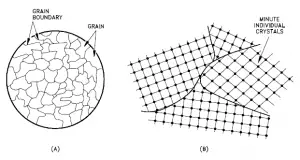Hall-Petch Equation – Hall-Petch method

Grain-boundary strengthening (or Hall–Petch strengthening) is a method of strengthening materials by changing their average crystallite (grain) size. The size of the grain determines the properties of the metal. For example, smaller grain size increases tensile strength and tends to increase ductility. A larger grain size is preferred for improved high-temperature creep properties. Decreasing the grain size also is an effective way to increase ductility. When grain size is reduced, there are more grains with a greater number of arbitrarily aligned slip planes for the dislocations in the grains. This provides more opportunity for some slip to occur in a stressed material. Grain boundaries act as an impediment to dislocation motion for the following two reasons:
- Dislocation must change its direction of motion due to the differing orientation of grains.
- Discontinuity of slip planes from grain one to grain two.
Thus, grain refinement provides an important means to improve not only strength, but also ductility and toughness. Many other strengthening mechanisms are achieved at the expense of ductility and toughness. For many materials, the yield strength σ varies with grain size according to
σy = σy,0 + k/dx
In this expression, termed the Hall–Petch equation, k is a constant, d is the average grain diameter and σy,0 is the original yield stress. Note that this equation is not valid for both very large (i.e., coarse) grain and extremely fine grain polycrystalline materials.
The synergistic effect of alloying elements and heat treatment produces a tremendous variety of microstructures and properties of steels.
- Vanadium. Vanadium is generally added to steel to inhibit grain growth during heat treatment. In controlling grain growth, it improves both the strength and toughness of hardened and tempered steels. The size of the grain determines the properties of the metal. For example, smaller grain size increases tensile strength and tends to increase ductility. A larger grain size is preferred for improved high-temperature creep properties.
- Tungsten. Tungsten produces stable carbides and refines grain size so as to increase hardness, particularly at high temperatures. Tungsten is used extensively in high-speed tool steels and has been proposed as a substitute for molybdenum in reduced-activation ferritic steels for nuclear applications.
We hope, this article, Hall-Petch Equation – Hall-Petch method, helps you. If so, give us a like in the sidebar. Main purpose of this website is to help the public to learn some interesting and important information about materials and their properties.